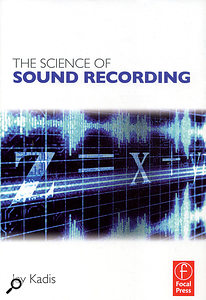It's a sad but true fact that most 'sound engineers' actually struggle with some of the technical and mathematical aspects that underpin audio engineering. Jay Kadis' new book, The Science of Sound Recording (Focal Press, ISBN 978-0-240-82154-2), aims to help overcome those difficulties with clear, well-written explanations of a wide range of technical subjects related to sound recording. Its A5 size and 200-ish page count makes this quite an approachable work and, while it employs A-level/degree-level maths occasionally — but only where necessary to explain a point — it also explains the necessary maths theory in Chapter One, for those who have forgotten, become rusty, or never knew!
 Chapter Two revisits the basic relevant physics — Newton's laws of mechanics, thermodynamics, electromagnetism, work and energy, resonance and harmonic motion, the Wave Equation, and superposition — while Chapter Three looks as the specific physics of sound, including propagation through gases, refraction, diffraction and reflection, acoustics and room modes.
Chapter Two revisits the basic relevant physics — Newton's laws of mechanics, thermodynamics, electromagnetism, work and energy, resonance and harmonic motion, the Wave Equation, and superposition — while Chapter Three looks as the specific physics of sound, including propagation through gases, refraction, diffraction and reflection, acoustics and room modes.
Of course, what the physics says we should hear and what we actually hear are often quite different things, and Chapter Four describes the human auditory system and cochlear physiology in quite some detail, along with the implications and practical outcomes for sound perception. The final 'abstract theory' section of the book is Chapter Five's exploration of electronics, starting with basic electrical theory, followed by a brief examination of common passive and active devices associated with audio equipment.
The remaining five chapters work their way steadily through the studio signal path, starting with microphones (the different types, specifications and applications) to analogue signal processing (impedance matching, shielding grounding and balanced lines, linear and non-linear amplifiers, dynamic range processing, EQ, and mixing). The book continues with analogue recorders (magnetism and the theory of magnetic recording, head-tape interactions, noise reduction, and recorder alignment), and digital audio conversion, recording and processing. The final chapter covers monitoring in terms of loudspeaker drivers and cabinets, loudspeaker-room interactions, and mixing and mastering concepts.
Each chapter occupies roughly 20 pages to cover its subject matter, and the diagrams throughout are clear and unambiguous. Indeed, much the same can be said for the text, which is technically precise and accurate, but always very readable. I was very pleased, if not relieved, to find that explanations of inherently complex topics — such as digital sampling and quantisation — are absolutely spot-on in the technical sense, without over-simplification or convenient overlooking of the more difficult bits. Where necessary, maths is used to prove or confirm the critical points, but not in a way that disrupts the flow, and only when a grasp of the maths has a positive benefit for understanding of the topic. Every chapter also includes detailed further reading suggestions, mostly linking to well known and worthy reference tomes in the Focal and McGraw Hill archives.
Following a short appendix (comprising worked examples of calculations involving decibels), and a comprehensive index, the book closes with a chapter reprint borrowed from The Handbook For Sound Engineers, edited by Glen Ballou. This is a chapter written by Pat Brown all about audio and acoustic measurement techniques, and it forms a supplement that complements and balances nicely with the rest of the book.
I found The Science of Sound Recording a thoroughly good read, and would strongly recommend it as either a general reference primer for students of audio engineering, or as a valuable refresher for those who may be a little longer in the tooth, and who might perhaps benefit from reminding themselves of long-forgotten principles and details! This is a very cost-effective reference book — and one that will be placed within easy reach on my office bookshelf. Highly recommended.
Paperback £24.99; Kindle Edition £18.69 including VAT.$39.95.
